Previous FI Curriculum – Ch. 2
Avoir – to have
The verb avoir is irregular in the present tense. Listen carefully to the pronunciation of the -s in the plural pronouns nous, vous, and ils/elles. This -s is pronounced as a /z/ to link with the vowel sound in the plural forms of avoir. This liaison, or linking, is especially important in distinguishing ils ont (they have) from the third person plural of être ils sont (they are).
| avoir ‘to have’ | |
| j’ai | nous avons |
| tu as | vous avez |
| il/elle/on a | ils/elles ont |
| past participle: eu | |
Avoir is also used as an auxiliary in compound tenses (passé composé with avoir, plus-que-parfait, futur antérieur, etc.) Besides ownership, the verb avoir expresses age in French, unlike the English equivalent, which uses the verb ‘to be.’
| Tex, tu as des frères et des soeurs? | Tex, do you have brothers and sisters? |
| Tex: Oui, j’ai une soeur et un frère. | Tex: Yes, I have a sister and a brother. |
| Quel âge ont-ils? | How old are they? |
| Tex: Ma soeur Rita a 30 ans et mon frère Trey a 16 ans. | Tex: My sister Rita is 30 and my brother Trey is 16. |

Listening Comprehension:
1
2
3
4
5
6
7
8
9
10
11
12
-er verbs (regular) – present tense
There are three major groups of regular verbs in French: verbs with infinitives ending in -er, verbs with infinitives ending in -ir, and verbs with infinitives ending in -re. Since -er verbs are the most numerous, they are considered the first conjugation. To conjugate these verbs, drop the -er from the infinitive to form the stem. Next, add the –er endings to the stem. Different tenses have different endings.
The endings given below (-e, –es, -e, -ons, -ez, -ent) are for forming the present tense. The endings (-e, -es, -e, and –ent) are all silent. The only endings that are pronounced are the nous (-ons) and the vous (-ez) endings. The four silent endings form a boot shape in the verb conjugation.
| parler ‘to speak’ | |
| je parle | nous parlons |
| tu parles | vous parlez |
| il/elle/on parle | ils/elles parlent |
| past participle: parlé | |
Listen carefully to the following sentences. Note that the pronunciation of each of the verbs is the same even though the conjugations are spelled differently.
| Tex, il parle français? Mais c’est un tatou. | Tex speaks French? But he’s an armadillo. |
| Tex: Bien sûr je parle français etTammy, elle aussi, elle parle français. | Tex: Of course, I speak French and Tammy,too, she speaks French. |
| Eh bien dis donc, même les tatous parlent français au Texas? | Well, I’ll be, even the armadillos speak French in Texas? |
Here is a list of common -er verbs:
| adorer | to adore |
| aimer | to like |
| aimermieux | to prefer |
| chanter | to sing |
| chercher | to look for |
| danser | to dance |
| demander | to ask |
| détester | to hate, to detest |
| donner | to give |
| écouter | to listen |
| étudier | to study |
| habiter | to live |
| jouer | to play |
| montrer | to show |
| présenter | to introduce |
| regarder | to watch |
| rencontrer | to meet (by chance) |
| rester | to stay, remain |
| téléphoner | to telephone |
| travailler | to work |
| trouver | to find |
Je changes to j’ before a verb starting with a vowel or a silent h (ex. j’adore, j’habite). This phenomenon is known as élision. Listen to the following sentences. Can you hear the élision in the first two examples?
| Tex: J’adore la musique rap et j’écoute souvent de la musique dans les clubs. | I love rap music and I often listen to music in clubs. |
| Je chante et je danse aussi. | I sing and I dance, too. |

Note also that the s in plural pronouns (nous, vous, and ils/elles) is usually silent except when it is followed by a verb that begins with a vowel sound. In such a case the silent s is pronounced as a /z/ and links the pronoun to the verb. This phenomenon is called liaison (‘linking’) and is very characteristic of French. Listen carefully to the sentences below. Which sentences contain examples of liaison?
| Tex et Tammy, ils écoutent de la musique cadienne avec Paw-Paw! | Tex and Tammy, they listen to Cajun music with Paw-Paw! |
| Tammy: Nous adorons danser. | Tammy: We love to dance. |
| Tex: Oui, oui, c’est vrai. Nous dansons beaucoup. | Tex: Yes, yes, that’s true. We dance a lot. |
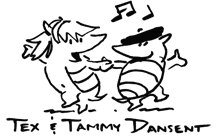
Listening Comprehension:
1
2
3
4
5
6
7
8
9
10
11
12
Possessive determiners
forms and uses
The possessive determiners serve to express ownership or possession (hence the name). They are also often called possessive adjectives because they agree in gender and number with the noun they introduce.
| Masculine singular |
Feminine singular |
Plural | Translation |
| mon | ma | mes | my |
| ton | ta | tes | your (familiar) |
| son | sa | ses | his or her or its |
| notre | notre | nos | our |
| votre | votre | vos | your (formal or plural) |
| leur | leur | leurs | their |
Possessive articles, like all articles, must agree with the noun they modify. Thus, if the noun is feminine, the possessive article must be feminine, too. In the following example, the feminine noun famille requires a feminine form – sa. Note that sa has three potential translations in English: ‘his,’ ‘her,’ or ‘its.’ So, how do you know which meaning is intended? Context! Since the following example sentence refers to Tex, we know that sa means ‘his.’
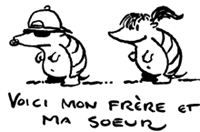
| Tex présente sa famille: Voici mon frère, Trey, et ma soeur, Rita, avec ses enfants et leur chien Fido. Notre famille est formidable! | Tex introduces his family. Here is my brother, Trey, and my sister, Rita with her children and their dog Fido. Our family is great! |
liaison
Do not forget to make the liaison between the plural forms of the possessive determiners and words that begin with a vowel sound. Ma, ta, sa become mon, ton, son in front of feminine nouns beginning with a vowel sound.
Tex continues his introductions:
| Tex: Voici Tammy, mon amie, et ses amies Bette et Fiona, c’est-à-dire nos amies. | Tex: Here is Tammy, my friend, and her friends, Bette and Fiona, that is to say, our friends. |
Listen to the dialogue:
| Tammy parle avec Bette: Tex n’est plus mon ami! Il a complètement oublié mon cadeau et notre anniversaire! Il a oublié toutes ses promesses! Quel nul! | Tammy is talking with Bette: Tex is not my friend any more! He completely forgot my present and our anniversary! He forgot all his promises. What a loser! |
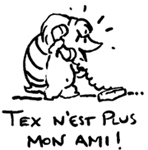
Yes/no questions; Est-ce que… ; N’est-ce pas
questions with intonation
One of the easiest ways to ask a question that may be answered by yes/no is to raise the pitch of your voice at the end of a statement. In a declarative statement, the pitch normally falls. Listen to the following dialogue and pay close attention to the intonation.
| Tex: Trey, tu aimes la philosophie? | Tex: Trey, do you like philosophy? |
| Trey: Non. Je n’aime pas la philosophie. | Trey: No. I do not like philosophy. |
| Tex: Tu connais Sartre? | Tex: Do you know Sartre? |
| Trey: Non. Qui est-ce? | Trey: No. Who is that? |
| Tex: Gloups! C’est l’auteur du chef d’oeuvre existentialiste, La Nausée. | Tex: Gulp! He’s the author of the existentialist masterpiece, Nausea. |
questions using ‘est-ce que … ?’
Another way to ask a yes/no question is to place est-ce que before a statement. Note that que becomes qu’ before a vowel.
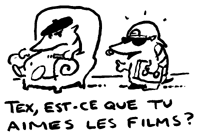
| Trey: Et toi, Tex, est-ce que tu aimes les films? | Trey: And you, Tex, do you like films? |
| Tex: Bien sûr, j’adore les films. | Tex: Of course, I adore films. |
| Trey: Est-ce que tu connais Yoda? | Trey: Do you know Yoda? |
| Tex: Non. Qui est-ce? | Tex: No. Who is that? |
| Trey: Duh … | Trey: Duh … |
questions using ‘n’est-ce pas ?’
N’est-ce pas? is added to the end of a yes/no question when the speaker expects an affirmative response.
| Trey: Tu connais ‘La guerre des étoiles,’ n’est-ce pas? Yoda, c’est le petit sage. | Trey: You know ‘Star Wars,’ don’t you? Yoda is the little wise man. |
Listen to the end of the dialogue:

| Trey: Yoda est mon héros. Tu ne connais pas Yoda? | Trey: Yoda is my hero. You don’t know Yoda? |
| Tex: Ah, si, si, si*, je connais le petit philosophe. Est-ce que tu es fou? Yoda n’est pas Sartre. | Tex: Ah, yes, yes, yes, I do know the little philosopher. Are you crazy? Yoda is not Sartre. |
| Trey: Oh, mais la philosophie de Yoda est plus intéressante que la philosophie existentialiste de La Nausée! Tu es d’accord, n’est-ce pas? | Trey: Oh, but Yoda’s philosophy is more interesting than the existentialist philosophy of La Nausée! You agree, don’t you? |
| Tex: Quel crétin! Retourne à tes jeux électroniques! | Tex: What an idiot! Go back to your video games! |
*Si is used to answer ‘yes’ to a negative question.
Basic negation: ne… pas
Basic negation is formed by placing ne … pas around the conjugated verb. Ne becomes n’ in front of a verb starting with a vowel or a mute h.
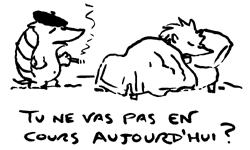
| Tex: Tu ne vas pas en cours aujourd’hui, Tammy? | Tex: You’re not going to class today Tammy? |
| Tammy: Non. Je ne vais pas bien. Je ne peux pas manger et j’ai mal à la tête. | Tammy: No. I am not well. I cannot eat and I have a headache. |
| Tex: Tu n‘as pas de chance! Ce soir, il y a une fête chez Edouard! | Tex: That’s too bad [literally ‘you are not lucky’]! Tonight there is a party at Edouard’s! |
| Tammy: Tu n‘es pas d’un grand réconfort, tu sais! | Tammy: You are not a lot of comfort, you know! |
In compound tenses, like the passé composé, the ne … pas are also placed around the conjugated verb, which is the auxiliary, avoir or être. In the periphrastic future, ne … pas goes around the verb aller.
| Tex n‘a pas été très gentil. | Tex was not very nice. |
| Tammy ne va pas passer la soirée chez Edouard. | Tammy is not going to spend the evening at Edouard’s. |
Note that in spoken French, the ne / n‘ is sometimes dropped. In familiar speech, tu is often pronounced as t’ before a vowel.
Tammy: Tex, t’es (tu es) pas très gentil. Tammy: Tex, you are not very nice.
Introduction to adverbs
An adverb is a word that qualifies the action of the verb, that is, it specifies how or when the action is performed. In English, many adverbs are indicated by the -ly ending. In French, most adverbs end in -ment.
| lentement | slowly |
| attentivement | carefully |
| souvent | often |
Adverbs answer questions about the action: how? how much? when? and where? While most adverbs in French and English modify verbs, they can also modify other adverbs as well as adjectives.
| verb modified by adverb | Ecoute attentivement. | Listen carefully. |
| adverb modified by adverb | trop lentement | too slowly |
| adjective modified by adverb | extrêmement silencieux | extremely quiet |
Adverb vs. Adjective
It is common in non-standard English for speakers to use adjectives in place of adverbs.
- Tex writes good. (instead of ‘well’)
- Aggies talk too slow. (instead of ‘slowly’)
While this alternation is common in English, it is not common in French where adjectives are rarely used in place of the adverb. Remember that adverbs modify verbs (as well as other adverbs and adjectives) and adjectives modify nouns.
| Tex écrit bien. | Tex writes well. |
| La poésie de Tex est bonne. | Tex’s poetry is good. |
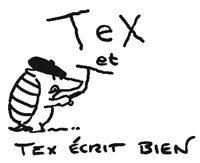
Interrogative and exclamative quel
Quel is an adjective. Like any other adjective, it agrees in number and gender with the noun it modifies. Remember to make the liaison between quels / quelles and a following word beginning with a vowel (quels animaux).
| masculine singular | masculine plural | feminine singular | feminine plural |
| quel | quels | quelle | quelles |
interrogative quel
Quel is generally translated into English by ‘what’ or ‘which’. It is always followed by a noun or by the verb ‘être’ + noun.
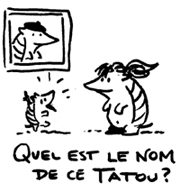
| Un petit tatou: Maman, maman, quel est le nom de ce tatou? | A little armadillo: What’s the name of this armadillo? |
| Rita: Oh, c’est Tex, ton oncle. | Rita: Oh, it’s Tex, your uncle. |
| Un petit tatou: Quel âge a Tex? | A little armadillo: How old is Tex? |
| Rita: On ne sait pas. | Rita: We don’t know. |
| Un petit tatou: Quelles sont les qualités de Tex? | A little armadillo: What are Tex’s good points? |
| Rita: Oh, il est intelligent, débrouillard, mais aussi cynique et pessimiste. | Rita: Oh, he’s intelligent, resourceful, but also cynical and pessimistic. |
exclamative quel
Quel may also be used for emphasis. In this instance, quel is followed either by an adjective or a noun, and it means ‘what’ or ‘what a’. Note that there is an exclamation mark at the end of the sentence.
| Tammy: Quel beau tatou! | Tammy: What a handsome armadillo! |
| Joe-Bob: Non, quel tatou snob! Quelle belle minette! | Joe-Bob: No, what a snobby armadillo! What a beautiful kitty! |
| Tammy: Quelle chatte méchante! | Tammy: What a mean cat! |
| Ah, quels animaux absurdes! | Ah, what absurd animals! |
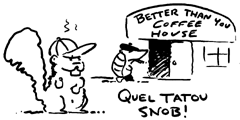
Introduction to adjectives
An adjective is a word that describes a noun or pronoun. The major differences between adjectives in French and English concern agreement and placement. In French, an adjective is usually placed after the noun it modifies and must agree in gender and number with the noun. In English, an adjective usually comes before the noun it modifies and is invariable, that is, it does not agree.
| Tex est un tatou philosophique. | Tex is a philosophical armadillo. |
| Edouard est un escargot raffiné. | Edouard is a refined snail. |
| Joe-Bob est un écureuil aimable. | Joe-Bob is a friendly squirrel. |
| Bette est une chatte capricieuse. | Bette is a temperamental cat. |
| Corey est un cafard ivre. | Corey is an intoxicated cockroach. |
| Fiona est travailleuse. (f) | Fiona is hard-working. |
| Mais Joe-Bob n’est pas travailleur. (m) | But Joe-Bob isn’t hard-working. |
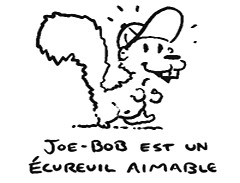
adjective vs. adverb
It is common in nonstandard English for speakers to use adjectives in place of adverbs.
- Joe-Bob says: “Gee, Tex writes real good.” (instead of: “Tex writes well.“)
- Joe-Bob says “Gosh, Edouard, you walk real slow.” (instead of: “Edouard, you talk slowly.“)
French adjectives are rarely used in place of the adverbial form. Remember that adjectives modify nouns and adverbs modify verbs, adjectives, and other adverbs!
| Tex écrit bien. (adverb modifies verb) |
Tex writes well. |
| La poésie de Tex est bonne. (adjective modifies noun) |
Tex’s poetry is good. |
Adjectives: Formation & placement
formation
Adjectives agree in both number and gender with the noun or pronoun they modify. For regular adjectives the masculine form is the base form to which endings are added. The feminine adjective is formed by adding an e. The plural adjective is formed by adding s. Listen to the recorded examples to hear the pronunciation of the different adjective forms:
| masculine singular |
feminine singular |
masculine plural |
feminine plural |
| petit | petite | petits | petites |
Note how the singular and plural forms of the masculine adjective sound the same, and the singular and plural forms of the feminine adjective also sound the same.
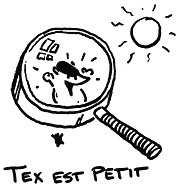
| Tex est petit. | Tex is little. |
| Tammy est petite. | Tammy is little. |
| Tex et Trey sont petits. | Tex and Trey are little. |
| Tammy et Bette sont petites. | Tammy and Bette are little. |
The adjective takes the masculine plural when the nouns it modifies are of different genders: Tammy et Tex sont petits. (Tammy and Tex are little.)
Irregular adjectives do not follow the rules given above.
placement
In French, most adjectives follow the noun, unlike in English, where the the adjective precedes the noun. Here are some examples of adjectives following the noun:
| Tex porte toujours un béret rond, même quand il fait du sport. Il aime les romans existentialistes. Dans son enfance, Tex a habité chez des nonnes catholiques. | Tex always wears a round beret, even when he exercises. He likes existentialist novels. As a child, Tex lived with catholic nuns. |
| Tammy a un nez pointu. C’est une tatou mince et sympathique. Elle apprend la langue française et fait des études littéraires. | Tammy has a pointed nose. She is a slim and nice armadillo. She’s learning the French language and is studying literature. |
| Bette est de caractère méfiant. Elle est d’humeur changeante. C’est une chatte très maline. | Bette has a mistrustful personality. She has changing moods. She’s a very cunning cat. |
Note that there is a small group of adjectives that normally precede the noun. Some adjectives can also be placed before or after the noun but changing the position of the adjectives can modify their meaning.
Listen to this dialogue:
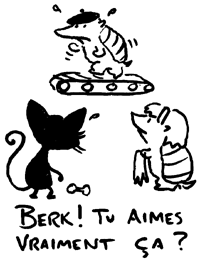
| Tammy, Bette et Tex sont à Gregory Gym. Les deux filles parlent, puis se disputent, pendant que Tex fait son sport annuel. | Tammy, Bette and Tex are at Gregory Gym. The two girls talk, then argue, while Tex does his yearly workout. |
| Tammy: Regarde, Bette, comme ses ongles jaunes tapent sur le tapis roulant quand il court! Quel tatou adorable! Et ce museau fin et pointu, ces écailles étincelantes, ce corps souple, ces gestes et ces mouvements pleins de grâce … | Tammy: Bette, would you look at those yellow nails of his clicking on the tread mill when he runs! What an adorable armadillo! And that snout, so fine and pointy! Those shiny scales, that supple body, his every gesture and movement so full of grace … |
| Bette: Berk! Tu aimes vraiment ça!? Un corps humide de sueur et un poil gris comme une boule de papier mâché! Oh mon dieu! Et cette odeur désagréable! Comme un rat noyé! Tu n’es pas sérieuse! | Bette: Yuck! You like that!? That clammy body, gray fur? Like a wad of paper maché! Oh, Lord! And that awful smell! Like a drowned rat! You’re not serious! |
| Tammy: Bette, je ne suis pas idiote! Je connais tes intentions! Il est à moi! | Tammy: Bette, you don’t fool me! I understand your intentions! He’s mine! |

